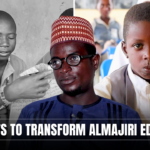Susa Rodríguez-Garrido is the founder of Agama Art Publishing and Agency Limited. She is also an artist, publisher and curator that has been doing well in the art scene promoting African artists. Her collaborations extend to artistic collaborations, working with embassies, NGOs, the Female Artists Association of Nigeria (FEAAN) and the Society of Nigerian Artists (SNA) while also doing her art digital editorial work remotely for different London companies. In this interview, she speaks on the uniqueness of Nigerian artists and what they can do to get global relevance.
You’ve been in Nigeria for a while, what gave you the impression that this is a place worth staying considering your goals?
Nigeria is an incredible country full of potential, talent and beauty. This is reflected in their art world and their artists. When I arrived here, I saw a vibrant country with emerging and promising artists who needed to be mentored, encouraged and promoted. As an artist myself, I know how difficult it is to make it in the art world and how challenging it is. As a curator and founder of Agama Art Publishing & Agency, an art organisation that promotes African artists, I have the skills to assist these artists to achieve bigger stages and to advise them on what steps to take for the next level of their careers.

FG confirms outbreaks of swarm birds, locusts
60th birthday: Continue to serve Nigeria well, Buhari tells Gbajabiamila
You’ve worked with several talented artists in Nigeria, what are those things that impress you about their works?
There are so many amazing artists in Nigeria, who impressed me and continue to do so. Their energy, their skills, their passion, their courage to improve, to do better, to push boundaries with their art, to speak up about topics that can be problematic or painful and above all their resilience to carry on, on occasions, under hard conditions have been very inspiring to me. Furthermore, the works that I have seen emanated originality and freshness that includes elements of each of the artists’ cultures from a different and unique perspective.
As a curator, what guides in selecting works in line with a given theme for an exhibition or event?
There are different ways of working when planning an exhibition, there is no correct way of doing things, and everybody has different methods of approaching an event. I work very closely with artists and we can propose an exhibition with a theme that we have developed or we can set up an exhibition with a theme that has been given to us previously. Regarding the latter, we would research the theme and come up with different ideas, by brainstorming. Then, we could proceed with sketching them to see where this gets us when we are happy the work is created on the final medium that is selected. This is a simplistic way of explaining the process, of course, there are other elements that we take into consideration such as the space, where we are going to exhibit; the number of works; the sizes; the medium; the catalogue, etc.
What are some of the misconceptions about Nigerian artists that your visit/stay has helped clarified?
I can say that I did not come with misconceptions about Nigerian artists. I try to look at things as objectively as possible otherwise, this could interrupt my work as an artist, as a curator and as a promoter of art through my organisation. Perhaps this comes from my training as an artist and how we interpret life and everything that surrounds us, which tends to be more as potential and beauty rather than limitation, so having preconceived ideas of artists would be detrimental to my line of work and would not allow me to find the hidden gems that need to be nurtured.
What do you think Nigerian artists can do to get more global relevance, and recognition?
Art can be influenced by anything, especially nowadays when the world is more connected with the internet and social media. A fair number of Nigerian artists now are very perceptive, so in that respect, they do not need input. It is challenging for any artists in the world to get more recognition, it is a very competitive field. Yes, it is true that Nigerian artists need to be promoted, supported and guided more as I mentioned earlier. It is also correct to say that there is not enough funding available for them to experience other art communities and techniques, there are not too many organisations that spend time cultivating and exporting them to the international scene. It is hard for them to get visas to travel and acquire the necessary economical means to do so. There should be governmental support that works in collaboration with organisations like mine to put more art proposals in place.
You’ve participated in several events since your arrival in the country, what will you describe as the high point?
Initially, my high point was being in Nigeria, learning and experiencing the culture, the people and the art. Regarding my events, I am very proud of collaborating with different diplomatic missions, art organisations and NGOs. Some memorable art projects for me were the all-female artists’ exhibition in 2019 at the British Village Inn arranged by my organisation, the 2019 Queen’s Birthday Party exhibition that we set up for the British High Commission, the Afro-descendants’ exhibitions by the Embassy of the Argentine Republic in 2019 and 2021. Presenting my book Abuja Buildings with my Nigerian collaborators (Olorunyemi Kolapo, Ifeanyi Ezeh and Ruth Utsu) at the Residence of the Spanish Ambassador, Marcelino Cabanas, in 2021, was another focal point to mention, even though it was introduced during Covid times and it was a small event. In February 2022, I had the pleasure of taking Olorunyemi Kolapo, a very talented and serious Nigerian artist; to Spain in what was his first international solo exhibition. It was an honour for me to be one of the panellists at the “Orange the World: Fund, Respond, Prevent, Collect!” organised by Plan International at the Thought Pyramid Centre to discuss gender inequality through the point of view of art and how art can be beneficial in increasing awareness. My main highlight will also be my two solo exhibitions of my work that are planned for October 2022 and the beginning of 2023.
Can you let Nigerians know some of your plans?
I can say that I have been offering and devoting my experience, my skills, my advice and my time to promote emerging Nigerian artists by organising international exhibitions in Spain and the UK, residencies and workshops and supporting mid-career artists in their journey. I will continue my passion and my efforts in doing so and in collaborating with good causes and serious organisations that have art and artists at their centre.
I have artists and their interests at heart and I have unique skills that can help them in achieving their dreams. Next year, we have a full schedule already with international art events, residencies, workshops, art seminars and annual cultural exchange that we are hoping will be the reference point in the Nigerian art world for many years to come.
Do you think that Nigerian female artists get the same recognition as their male counterparts?
Sadly, I do not think so. Even though it is hard for any artists to sustain themselves, male artists seem to have more opportunities and more recognition, but it is changing due to the strength of these female artists and the diligence of some entities, including me with events, workshops and exhibitions that highlight the amazing talent of female artists.

 Join Daily Trust WhatsApp Community For Quick Access To News and Happenings Around You.
Join Daily Trust WhatsApp Community For Quick Access To News and Happenings Around You.


